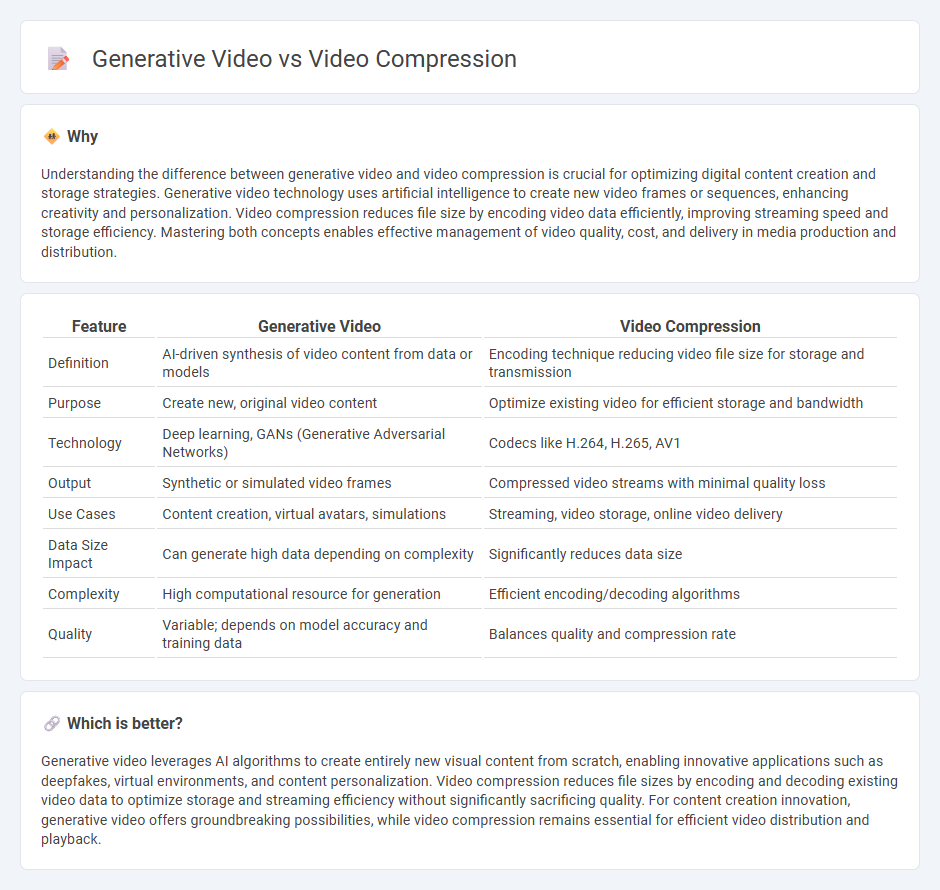
Generative video technology creates new video content using AI algorithms, enhancing creativity and personalization, while video compression reduces file sizes to optimize storage and streaming efficiency without significantly sacrificing quality. Innovations in generative video focus on realistic frame synthesis and content generation, whereas video compression advances prioritize codec development and bitrate reduction. Explore more to understand how these technologies shape the future of video production and distribution.
Why it is important
Understanding the difference between generative video and video compression is crucial for optimizing digital content creation and storage strategies. Generative video technology uses artificial intelligence to create new video frames or sequences, enhancing creativity and personalization. Video compression reduces file size by encoding video data efficiently, improving streaming speed and storage efficiency. Mastering both concepts enables effective management of video quality, cost, and delivery in media production and distribution.
Comparison Table
| Feature | Generative Video | Video Compression |
|---|---|---|
| Definition | AI-driven synthesis of video content from data or models | Encoding technique reducing video file size for storage and transmission |
| Purpose | Create new, original video content | Optimize existing video for efficient storage and bandwidth |
| Technology | Deep learning, GANs (Generative Adversarial Networks) | Codecs like H.264, H.265, AV1 |
| Output | Synthetic or simulated video frames | Compressed video streams with minimal quality loss |
| Use Cases | Content creation, virtual avatars, simulations | Streaming, video storage, online video delivery |
| Data Size Impact | Can generate high data depending on complexity | Significantly reduces data size |
| Complexity | High computational resource for generation | Efficient encoding/decoding algorithms |
| Quality | Variable; depends on model accuracy and training data | Balances quality and compression rate |
Which is better?
Generative video leverages AI algorithms to create entirely new visual content from scratch, enabling innovative applications such as deepfakes, virtual environments, and content personalization. Video compression reduces file sizes by encoding and decoding existing video data to optimize storage and streaming efficiency without significantly sacrificing quality. For content creation innovation, generative video offers groundbreaking possibilities, while video compression remains essential for efficient video distribution and playback.
Connection
Generative video uses artificial intelligence algorithms to create new video content, which often results in large file sizes requiring efficient video compression techniques to reduce bandwidth and storage demands. Video compression algorithms like H.264 and HEVC optimize the delivery of generative video by minimizing redundant data without compromising quality. This synergy enables seamless streaming and sharing of AI-generated videos across digital platforms.
Key Terms
Codec
Video compression relies on codecs like H.264 and HEVC to reduce file sizes by removing redundant data while preserving visual quality. Generative video utilizes AI-driven models that create new frames or content, often requiring less bandwidth but demanding advanced codec integration to handle generated data efficiently. Explore the evolving roles of codecs in video technology to understand their impact on streaming and media consumption.
Bitrate
Video compression reduces bitrate by encoding and removing redundant data to optimize storage and streaming efficiency without significantly compromising visual quality. Generative video leverages AI models to synthesize or recreate video content, enabling ultra-low or adaptive bitrate usage by generating frames rather than transmitting raw data. Explore deeper insights into how bitrate management differs between these technologies and their impact on video delivery.
Diffusion model
Video compression techniques reduce file size by removing redundancy and encoding frames efficiently, optimizing storage and streaming capabilities. Generative video using diffusion models synthesizes high-quality frames by iteratively denoising latent representations, enabling realistic video creation and enhancement beyond traditional compression limits. Explore the innovative potential of diffusion-based generative video to revolutionize multimedia applications.
Source and External Links
Compress Video - No Loss in Video Quality - Effortlessly compress videos online with VEED in one click, adjust quality/resolution, and view real-time file size estimates without sacrificing visual quality.
Video Compression Guide - Compress video files using advanced codecs like H264 or H265 for good quality at smaller sizes, always keep a high-quality master, and understand that more compression typically means lower quality.
Video Compressor | Free, Private, Fast - Compress videos by up to 90% online, keep quality high, and process files directly in your browser without uploading to external servers.
 dowidth.com
dowidth.com